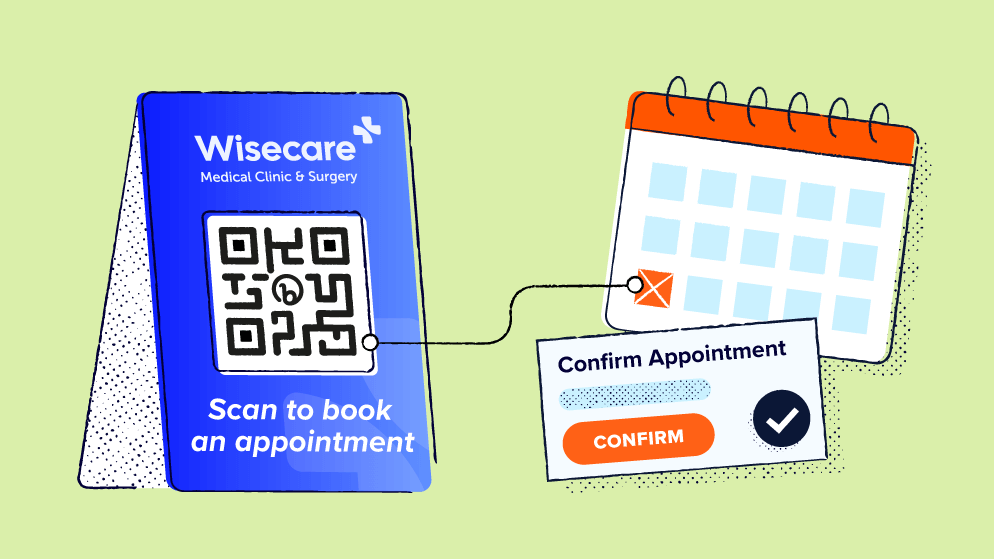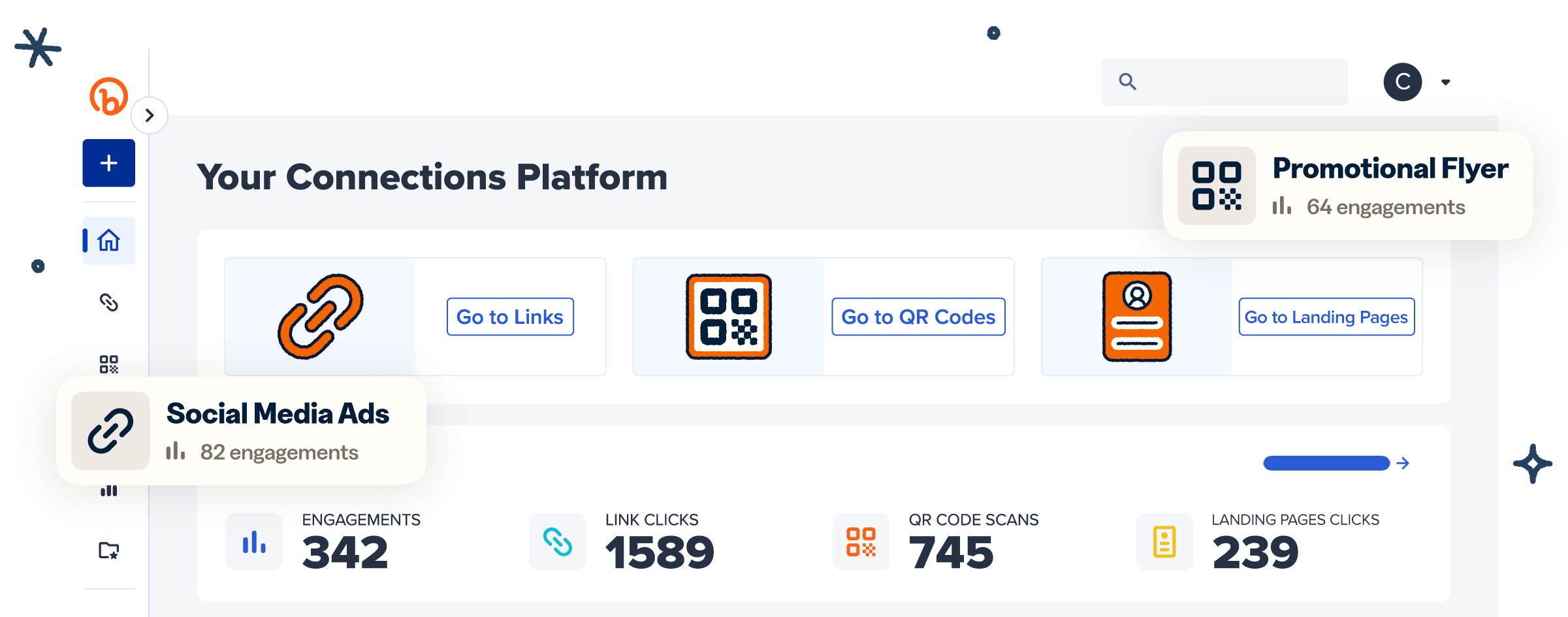QR Codes and healthcare—not words you ever imagined you’d use together some years back, right?
If there’s anything we can learn from the history of these nifty innovations, it’s to expect the unexpected. QR Codes have broken numerous barriers over the years, from simply being used in warehouses, retail stores, and restaurants to now being used in healthcare.
There’s a significant increase in QR Codes in healthcare settings, with hospitals using QR Code surveys to collect patient feedback and QR Code tags to facilitate seamless access to medical records. These malleable 2D barcodes are transforming services and patient care for the better, proving that some flexibility in healthcare can do a lot of good. Let’s explore how.
The rising trend of QR Codes in healthcare: What to know
The healthcare industry is undergoing a significant digital transformation as more institutions adopt innovative solutions to improve patient care and service delivery. This transformation is evident from projected digital healthcare market valuations—the market’s expected worth is a whopping $504.4 billion by 2025, which is more than most niches.
As such, it’s unsurprising to find a growing use of QR Codes in medical settings. They allow doctors to quickly identify patients and access medical information, promoting efficient service delivery.
Further, they help patients access on-demand healthcare by leading them directly to medical information, hospital websites, telehealth appointments, and more. With the ever-increasing demand for efficiency in healthcare, these solutions are indispensable.
Use cases for QR Codes in healthcare
As their name suggests, QR (Quick Response) Codes facilitate fast access to information. This fast access makes them valuable across numerous medical operations since the healthcare industry relies primarily on information.
Healthcare leaders and service teams use them for many purposes, including supply chain management, patient marketing, and appointment management. Here’s an in-depth look at the various use cases for QR Codes in healthcare:
Supply chain management
Medical supplies often pass through an extensive supply chain before reaching final healthcare practitioners or patients. For example, medication usually moves from pharmaceutical companies to multiple warehouses and pharmacies before finally reaching patients.
How do you get a clear picture of supplies’ movements through the supply chain? Simple: Use QR Codes. This allows employees to scan the QR Code and be directed to an inventory database document or website via URL that they can update with the item’s location.
Telemedicine
Telemedicine is healthcare’s new norm, evidenced by its ever-increasing adoption since the pandemic. It’s considerably cheaper than in-person treatment, with hospitals charging roughly $80 for an appointment instead of the $150 they typically charge for in-person checkups. So, patients with uncomplicated health issues and those with accessibility limitations often opt for it.
Accessing telemedicine services can be daunting, however, especially for non-tech-savvy individuals. You can make the process easier by providing a direct link to booking and appointment pages and teaching patients how to scan QR Codes. This way, they don’t have to type lengthy URLs to access resources.
QR Codes can also improve telemedicine services by providing a convenient way to collect patient feedback. Simply add a QR Code linking to a feedback form and ask patients to scan it after their appointments.
Drug safety
Did you know the global annual worth of drug counterfeiting is roughly $431 billion? Yes, you read that right. A significant number of drugs currently sold in pharmacies are counterfeit, as some prioritize huge discounts over ensuring patient safety.
QR Codes can play a crucial role in preventing counterfeiting. Some manufacturers embed them on drug packaging, allowing healthcare providers to confirm drugs’ authenticity before giving them to patients. But this isn’t their only role in promoting drug safety. QR Codes also provide easy access to drug content details, dosage recommendations, and administration guidelines via URL, allowing providers to ensure optimal patient care and safety.
Medical equipment information
How many times has your team had to delay service delivery waiting for a technician to show them how to use a piece of equipment or deal with a malfunction?
QR Codes can help your team become more self-sufficient by providing the information they need to operate equipment or deal with slight malfunctions. Simply link the QR Codes to equipment set-up and operation manuals and videos via URL and ask providers to scan them rather than wait for technicians. This strategy promotes operational efficiency and, over time, helps your team work more independently.
Asset management
Much as we try to paint healthcare as a practice people should respect, we live in a self-serving society where individual needs come before collective needs. So, it’s unsurprising that the healthcare industry is one of the hardest hit when it comes to theft, with hospitals reporting a 10% to 20% loss of mobile assets. Losses in healthcare not only have financial repercussions but also impact patients’ health, as medical personnel can’t adequately meet their needs without proper medical supplies.
QR Codes can boost efficient asset tracking, limiting the risk of item loss, theft, or mismanagement. Dynamic QR Codes can easily link to asset management databases via URL so employees can easily access information about an item’s status. This makes it easy to track the last people to use specific pieces of equipment should they go missing.
Patient marketing
As with other types of businesses, medical facilities require consistent revenue to remain operational. The only way to ensure this income is by maintaining a constant stream of patients, making marketing an essential operation.
QR Codes are the perfect marketing allies, as they bridge the gap between the physical and digital. You can use them to open your target audience up to a world of information, including your values, hospital infrastructure, and illnesses you treat.
There are numerous ways to use QR Codes for healthcare marketing. You can print them on marketing materials like flyers and billboards to boost your visibility and engagement, add them to your sign to direct patients to websites with information about a new medication option for people with specific diagnoses, or embed them in your emails to link to patient success stories.
Elderly care
Age-related decline in cognitive and physical functioning makes older adults more susceptible to getting lost than the general population. They’re also unlikely to remember their medical history or health information, making it vital for caregivers to become creative to ensure their safety.
You can embed QR Codes with health information on elderly patients’ badges, improving their chances of receiving high-quality health care. You can also use QR Codes to help disoriented patients find their way home and facilitate seamless emergency response. Connect the URL to a private web page URL with caregivers’ phone numbers or addresses. This can help emergency responders guide them home or reach medical professionals in case of emergencies.
Appointment management
Leaving patients in waiting rooms for hours negatively impacts your healthcare organization. It paints a poor picture of your practice and increases the risk of cross-contamination among patients.
QR Codes can help you manage your appointments effectively, improving patient experiences. There are various ways you can leverage them in appointment management:
- Embed them on your website to allow patients to schedule appointments seamlessly.
- Print them and stick them on locations like parking lots or practice entrances to allow patients to confirm their arrival. This way, your front office staff can process their check-in without necessarily asking them to queue in the waiting room.
- Hang them on bulletin boards to allow patients who need follow-up appointments to book seamlessly.
The future of QR Codes in healthcare
Innovators across various industries have shown us there’s no limit to the use of QR Codes. From marketing geniuses using drone QR Codes to reach broader target audiences to gaming experts using these nifty squares for in-game purchases and rewards, the possibilities are truly endless.
The healthcare industry has yet to explore the full potential of QR Codes. The future is promising, however, as more organizations incorporate them into their systems. There are many potential future use cases for QR Codes in healthcare, including:
- Augmented reality (AR) guidance: QR Codes can provide access to AR tools, allowing patients to learn self-administered medical procedures like drug injections from the comfort of their homes.
- Healthcare gamification: QR Codes can improve patient engagement and encourage them to participate in wellness programs by providing access to gamified healthcare apps.
- Global health passport: QR Codes can communicate travelers’ health information like vaccination histories, facilitating seamless international travel.
Whichever direction your organization decides to take, rest assured you have the right partner in Bitly. You can integrate Bitly’s QR Code solutions into these future developments, enhancing efficiency and patient care.
How to create healthcare QR Codes with Bitly
With Bitly’s QR Code generator, you can create custom QR Codes for a wide range of purposes, including appointment management, asset management, or even AR experiences, should you decide to propel your organization into the future. And the best part? The process is so straightforward you don’t need to be a tech whiz to get started. Here’s how to customize QR Codes with Bitly:
- Log into your account.
- Tap Create new and go to the QR Code option.
- Enter your Destination URL in the displayed box.
- Select Design your code.
- Customize the code by choosing your preferred Patterns, Corners, Colors, Frame, and Logo—make sure to choose contrasting colors for easy scannability. Note, this feature is only available in some plans.
- Select Save current design if you’re satisfied with the code’s appearance.
- Tap Create your code.
- Download the code.
When you’re done, print or add the code to your preferred medium—anything from hospital flyers to your website or emails. Ensure you maintain a minimum QR Code size of 2 cm x 2 cm for seamless scannability. Test the Code with different mobile devices to make sure it’s compatible and leads patients or healthcare providers to your landing page.
Pave the way to smarter, safer healthcare with Bitly’s QR Codes
Since the pandemic, QR Code usage in the healthcare industry has skyrocketed. Healthcare teams use QR Codes for numerous processes, including equipment management, marketing, patient identification, and more, protecting vital assets and limiting medical errors.
With Bitly’s innovative technology, you can quickly improve your organization’s operational efficiency and provide better patient care by generating reliable QR Codes. Whether you want your providers to be more self-sufficient, offer more convenience to your patients, or boost your practice’s visibility, rest assured you’ve found the right tool.
Explore Bitly’s pricing plans today to transform your healthcare facility into a well-oiled machine and improve patient outcomes.


